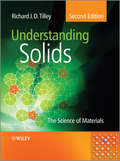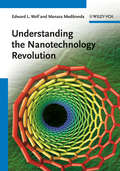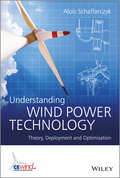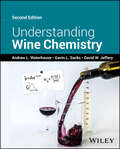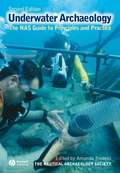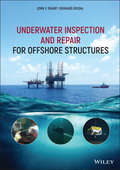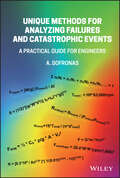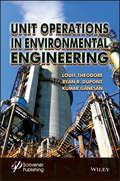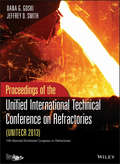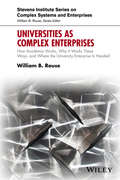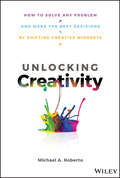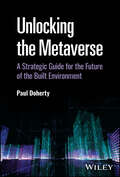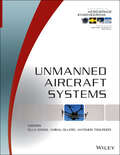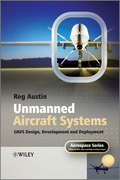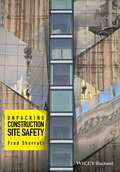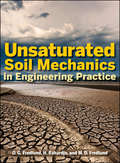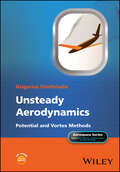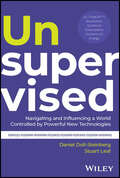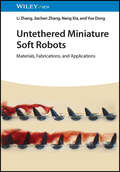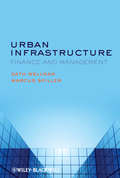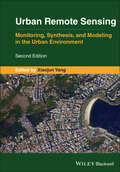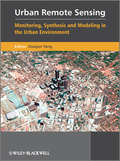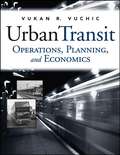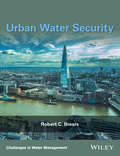- Table View
- List View
Understanding Solids
by Richard J. TilleyThe second edition of a modern introduction to the chemistry and physics of solids. This textbook takes a unique integrated approach designed to appeal to both science and engineering students.Review of 1st edition"an extremely wide-ranging, useful book that is accessible to anyone with a firm grasp of high school science...this is an outstanding and affordable resource for the lifelong learner or current student." Choice, 2005The book provides an introduction to the chemistry and physics of solids that acts as a foundation to courses in materials science, engineering, chemistry, and physics. It is equally accessible to both engineers and scientists, through its more scientific approach, whilst still covering the material essential to engineers.This edition contains new sections on the use of computing methods to solve materials problems and has been thoroughly updated to include the many developments and advances made in the past 10 years, e.g. batteries, solar cells, lighting technology, lasers, graphene and graphene electronics, carbon nanotubes, and the Fukashima nuclear disaster.The book is carefully structured into self-contained bite-sized chapters to enhance student understanding and questions have been designed to reinforce the concepts presented.The supplementary website includes Powerpoint slides and a host of additional problems and solutions.
Understanding the Nanotechnology Revolution
by Edward L. Wolf Manasa MedikondaA unique introduction for general readers to the underlying concepts of nanotechnology, covering a wide spectrum ranging from biology to quantum computing. The material is presented in the simplest possible way, including a few mathematical equations, but not mathematical derivations. It also outlines as simply as possible the major contributions to modern technology of physics-based nanophysical devices, such as the atomic clock, global positioning systems, and magnetic resonance imaging. As a result, readers are able to establish a connection between nanotechnology and day-to-day applications, as well as with advances in information technology based on fast computers, the internet, dense data storage, Google searches, and new concepts for renewable energy harvesting. Also of interest to professionals working in law, finance, or teaching who wish to understand nanotechnology in a broad context, and as general reading for electrical, chemical and computer engineers, materials scientists, applied physicists and mathematicians, as well as for students of these disciplines.
Understanding Wind Power Technology
by Alois SchaffarczykWind energy technology has progressed enormously over the last decade. In coming years it will continue to develop in terms of power ratings, performance and installed capacity of large wind turbines worldwide, with exciting developments in offshore installations.Designed to meet the training needs of wind engineers, this introductory text puts wind energy in context, from the natural resource to the assessment of cost effectiveness and bridges the gap between theory and practice. The thorough coverage spans the scientific basics, practical implementations and the modern state of technology used in onshore and offshore wind farms for electricity generation.Key features: provides in-depth treatment of all systems associated with wind energy, including the aerodynamic and structural aspects of blade design, the flow of energy and loads through the wind turbine, the electrical components and power electronics including control systems explains the importance of wind resource assessment techniques, site evaluation and ecology with a focus of project planning and operation describes the integration of wind farms into the electric grid and includes a whole chapter dedicated to offshore wind farms includes questions in each chapter for readers to test their knowledgeWritten by experts with deep experience in research, teaching and industry, this text conveys the importance of wind energy in the international energy-policy debate, and offers clear insight into the subject for postgraduates and final year undergraduate students studying all aspects of wind engineering. Understanding Wind Power Systems is also an authoritative resource for engineers designing and developing wind energy systems, energy policy makers, environmentalists, and economists in the renewable energy sector.
Understanding Wine Chemistry (Sci (society Of Chemical Industry) Ser.)
by David W. Jeffery Andrew L. Waterhouse Gavin L. SacksUnderstanding Wine Chemistry Understand the reactions behind the world’s most alluring beverages The immense variety of wines on the market is the product of multiple chemical processes – whether acting on components arising in the vineyard, during fermentation, or throughout storage. Winemaking decisions alter the chemistry of finished wines, affecting the flavor, color, stability, and other aspects of the final product. Knowledge of these chemical and biochemical processes is integral to the art and science of winemaking. Understanding Wine Chemistry has served as the definitive introduction to the chemical components of wine, their properties, and their reaction mechanisms. It equips the knowledgeable reader to interpret and predict the outcomes of physicochemical reactions involved with winemaking processes. Now updated to reflect recent research findings, most notably in relation to wine redox chemistry, along with new Special Topics chapters on emerging areas, it continues to set the standard in the subject. Readers of the second edition of Understanding Wine Chemistry will also find: Case studies throughout showing chemistry at work in creating different wine styles and avoiding common adverse chemical and sensory outcomes Detailed treatment of novel subjects like non-alcoholic wines, non-glass alternatives to wine packaging, synthetic wines, and more An authorial team with decades of combined experience in wine chemistry research and education Understanding Wine Chemistry is ideal for college and university students, winemakers at any stage in their practice, professionals in related fields such as suppliers or sommeliers, and chemists with an interest in wine.
Underwater Archaeology: The NAS Guide to Principles and Practice
by Nautical Archaeology Society (NAS)Underwater Archaeology: The NAS Guide to Principles and Practice provides a comprehensive summary of the archaeological process as applied in an underwater context. Long awaited second edition of what is popularly referred to as the NAS Handbook Provides a practical guide to underwater archaeology: how to get involved, basic principles, essential techniques, project planning and execution, publishing and presenting Fully illustrated with over 100 drawings and new colour graphics New chapters on geophysics, historical research, photography and video, monitoring and maintenance and conservation
Underwater Inspection and Repair for Offshore Structures
by John V. Sharp Gerhard ErsdalBenefit from a much-needed, up-to-date handbook on underwater inspection and repair processes and technologies Underwater Inspection and Repair for Offshore Structures fills a gap in the literature to provide an overview of the inspection and repair processes for both steel and concrete offshore structures. Authors and noted experts on the topic John Sharp and Gerhard Esdal guide readers through the reasons why inspection and repair are performed and how both are linked to the management of structural integrity, statutory requirements and various types of damage. The book addresses critical topics, including the execution and planning of inspection and repair and the tools and methods used and their deployment underwater. The authors put particular focus on steel and concrete offshore oil and gas installations, but the content is also applicable to the substructures of offshore wind turbines. Underwater Inspection and Repair for Offshore Structures is complementary to the authors’ book Ageing and Life Extension of Offshore Structures, also from Wiley. This important book: Covers current inspection and monitoring techniques to evaluate existing structures Includes coverage of robotic (ROV) inspection and repair methods Provides an overview of repair and maintenance techniques applicable to the splash-zone and underwater operations Written for engineers, designers and safety auditors working with offshore structures. Underwater Inspection and Repair for Offshore Structures is a comprehensive resource for understanding how to effectively inspect and repair these vulnerable structures.
Unique Methods for Analyzing Failures and Catastrophic Events: A Practical Guide for Engineers
by Anthony SofronasA practical and accessible approach to machinery troubleshooting Unique Methods for Analyzing Failures and Catastrophic Events is designed to assist practicing engineers address design and fabrication problems in manufacturing equipment to support safe process operation. Throughout the book, a wealth of real-world case studies and easy-to-understand illustrated examples demonstrate how to use simplified failure analysis methods to produce insights for a wide range of engineering problems. Dr. Anthony Sofronas draws from his five decades of industry experience to help engineers better understand the science behind a particular problem, evaluate the failure analysis of an outside consultant, and recommend the best path forward to management. The author distills sophisticated engineering analysis approaches into compact, user-friendly methodologies that can be easily applied to the readers’ own situations to avoid costly failures. Each chapter includes a thorough summary of the topic, relatable technical examples, and a concluding section with key takeaways and expert tips and advice. This invaluable guide: Helps readers make better decisions while solving complex engineering problems Provides numerous illustrated examples from engineering and science that can be used to develop real-world solutions Features detailed descriptions of both basic and advanced engineering analysis techniques Covers essential technical subjects that facilitate safe facility design and effective troubleshootingUnique Methods for Analyzing Failures and Catastrophic Events: An Illustrated Guide for Engineers is a must-have for chemical, petroleum, and mechanical engineers, reliability managers and technicians, design contractors, and maintenance workers working in process industries.
Unit Operations in Environmental Engineering
by Louis Theodore R. Ryan Dupont Kumar GanesanThe authors have written a practical introductory text exploring the theory and applications of unit operations for environmental engineers that is a comprehensive update to Linvil Rich’s 1961 classic work, “Unit Operations in Sanitary Engineering”. The book is designed to serve as a training tool for those individuals pursuing degrees that include courses on unit operations. Although the literature is inundated with publications in this area emphasizing theory and theoretical derivations, the goal of this book is to present the subject from a strictly pragmatic introductory point-of-view, particularly for those individuals involved with environmental engineering. This book is concerned with unit operations, fluid flow, heat transfer, and mass transfer. Unit operations, by definition, are physical processes although there are some that include chemical and biological reactions. The unit operations approach allows both the practicing engineer and student to compartmentalize the various operations that constitute a process, and emphasizes introductory engineering principles so that the reader can then satisfactorily predict the performance of the various unit operation equipment.
UNITECR 2013: Proceedings of the Unified International Technical Conference on Refractories
by Dana Goski Jeffrey D. SmithProceedings containing 231 manuscripts that were submitted and approved for the 13th biennial worldwide refractories congress recognized as the Unified International Technical Conference on Refractories(UNITECR), held September 10-13, 2013.
Universities as Complex Enterprises: How Academia Works, Why It Works These Ways, and Where the University Enterprise Is Headed
by William B. RouseExplores the nature of academic enterprises, including why they work the way they do and where such enterprises are headed, with the goal of gaining insights into where change can and will happen This book looks at universities from a whole-enterprise perspective. It explores the steady escalation of the costs of higher education and uses a computational economic model of complex academic enterprises. This model includes component models of research, teaching, administration, and brand value. Understanding the relationships among practices, processes, structure, and ecosystem provides the basis for transforming academia, leveraging its strengths and overcoming its limitations. More specifically, this architecture helps the reader understand how various elements of the enterprise system either enable or hinder other elements of the system, all of which are embedded in a complex behavioral and social ecosystem. Each topic is explored in terms of the levels of the architecture at which it primarily functions. Levers of change within each area are discussed, using many experiences of pursuing such issues in a range of academic enterprises. * Provides a new methodology by taking a more systems-oriented approach to education systems as a whole * Shows how various elements of the enterprise system either enable or hinder other elements of the system * Offers alternative strategies for transformation of academic enterprises Universities as Complex Enterprises: How Academia Works, Why It Works These Ways, and Where the University Enterprise Is Headed is a reference for systems scientists and engineers, economists, social scientists, and decision makers. William B. Rouse is the Alexander Crombie Humphreys Chair within the School of Systems & Enterprises and Director of the Center for Complex Systems and Enterprises at Stevens Institute of Technology, Hoboken, New Jersey. He is also Professor Emeritus, and former Chair, of the School of Industrial and Systems Engineering at the Georgia Institute of Technology, Atlanta, Georgia. Rouse has written hundreds of articles and book chapters, and has authored many books, including most recently Modeling and Visualization of Complex Systems and Enterprises (Wiley, 2015).
Unlocking Creativity: How to Solve Any Problem and Make the Best Decisions by Shifting Creative Mindsets
by Michael A. RobertoTear down the obstacles to creative innovation in your organization Unlocking Creativity is an exploration of the creative process and how organizations can clear the way for innovation. In many organizations, creative individuals face stubborn resistance to new ideas. Managers and executives oftentimes reject innovation and unconventional approaches due to misplaced allegiance to the status quo. Questioning established practices or challenging prevailing sentiments is frequently met with stiff resistance. In this climate of stifled creativity and inflexible adherence to conventional wisdom, potentially game-changing ideas are dismissed outright. Senior leaders claim to value creativity, yet often lack the knowledge to provide a creative framework. Unlocking Creativity offers effective methods and real-world examples of how the most successful organizations create cultures of innovation and experimentation. Best-selling author and scholar Michael Roberto presents a thorough investigation of organizational obstacles to creative thought. Highly relevant to the growth crises many enterprises face in today’s economic landscape, this book examines how to break barriers to spark creativity and foster new ideas. This insightful and informative work allows business executives, senior managers, and organization leaders to: Recognize the six organizational mindsets that impede creativity and innovation Learn how to tear down the barriers that obstruct the creative process Create an environment that allows talented people to thrive Encourage creative collaboration in teams throughout an organization Leaders do not have to conceive innovative ideas, but rather open the path for curious and creative employees within their organization. Unlocking Creativity: How to Solve Any Problem and Make the Best Decisions aids organizations in removing obstacles to the creative process and helps to form an atmosphere of imagination and innovation.
Unlocking the Metaverse: A Strategic Guide for the Future of the Built Environment
by Paul DohertyUnlocking the Metaverse Highly comprehensive resource providing insight into how the “Metaverse,” and digital worlds in general, can be leveraged for business success Unlocking the Metaverse focuses on the strategic implementation of processes and the execution of Metaverse strategies, technologies, and innovations and provides readers with real world tools and strategies to succeed with market demands. The text provides a clear and concise description of what the Metaverse is and what its value means to readers and their companies. A continuous interaction with readers inside the book’s virtual world in the Metaverse provides both structured and unstructured interactions with the highly qualified author and his guests in periodic and ongoing public events, serving as a repository of continuous learning and a sandbox for continuous innovations to be explored, analyzed, and reported. Unlocking the Metaverse covers sample topics such as: Construction documents and drawings, covering building information modeling (BIM), digital twins, virtual worlds, the metaverse, and level of experience/engagement measures Specifications changing role, covering specification manuals, lifecycle, 3D geolocation specs, and 3D search Smart contracts and tokenomics, DLT/blockchain, smart contracts, NFTs/FTs (digital building/digital asset), fractionalized ownership and digital real estate, and CBDCs, stablecoins, and crypto Future outlooks, covering machine learning and artificial intelligence (AI) as a whole, and its probable applications in gaming and robotics Providing authoritative coverage of an important and fast-evolving industry, Unlocking the Metaverse is an essential resource for architects, engineers, and contractors, facility managers and operators, and property owners who want to stay on the cutting edge of new forms of technology and leverage them to increase business success.
Unmanned Aircraft Systems
by Richard Blockley Wei ShyyCovering the design, development, operation and mission profiles of unmanned aircraft systems, this single, comprehensive volume forms a complete, stand-alone reference on the topic. The volume integrates with the online Wiley Encyclopedia of Aerospace Engineering, providing many new and updated articles for existing subscribers to that work.
Unmanned Aircraft Systems
by Reg AustinUnmanned Aircraft Systems delivers a much needed introduction to UAV System technology, taking an integrated approach that avoids compartmentalising the subject. Arranged in four sections, parts 1-3 examine the way in which various engineering disciplines affect the design, development and deployment of UAS. The fourth section assesses the future challenges and opportunities of UAS.Technological innovation and increasingly diverse applications are two key drivers of the rapid expansion of UAS technology. The global defence budget for UAS procurement is expanding, and in the future the market for civilian UAVs is expected to outmatch that of the military. Agriculture, meteorology, conservation and border control are just a few of the diverse areas in which UAVs are making a significant impact; the author addresses all of these applications, looking at the roles and technology behind both fixed wing and rotorcraft UAVs.Leading aeronautical consultant Reg Austin co-founded the Bristol International Remotely Piloted Vehicle (RPV) conferences in 1979, which are now the longest-established UAS conferences worldwide. In addition, Austin has over 40 years' experience in the design and development of UAS. One of Austin's programmes, the "Sprite UAV System" has been deployed around the world and operated by day and night, in all weathers.
Unpacking Construction Site Safety
by Fred SherrattUnpacking Construction Site Safety provides a different perspective of safety in practice. ? examines how useful the concept of safety actually is to the development of effective management interventions ? providing new insights and information to the audience, and assist in a more informed development of new approaches in practice ? aimed at safety and construction management practitioners as well as academics
Unsaturated Soil Mechanics in Engineering Practice
by D. G. Fredlund H. Rahardjo M. D. FredlundThe definitive guide to unsaturated soil-- from the world's experts on the subjectThis book builds upon and substantially updates Fredlund and Rahardjo's publication, Soil Mechanics for Unsaturated Soils, the current standard in the field of unsaturated soils. It provides readers with more thorough coverage of the state of the art of unsaturated soil behavior and better reflects the manner in which practical unsaturated soil engineering problems are solved. Retaining the fundamental physics of unsaturated soil behavior presented in the earlier book, this new publication places greater emphasis on the importance of the "soil-water characteristic curve" in solving practical engineering problems, as well as the quantification of thermal and moisture boundary conditions based on the use of weather data. Topics covered include:Theory to Practice of Unsaturated Soil MechanicsNature and Phase Properties of Unsaturated SoilState Variables for Unsaturated SoilsMeasurement and Estimation of State VariablesSoil-Water Characteristic Curves for Unsaturated SoilsGround Surface Moisture Flux Boundary ConditionsTheory of Water Flow through Unsaturated SoilsSolving Saturated/Unsaturated Water Flow ProblemsAir Flow through Unsaturated SoilsHeat Flow Analysis for Unsaturated SoilsShear Strength of Unsaturated SoilsShear Strength Applications in Plastic and Limit EquilibriumStress-Deformation Analysis for Unsaturated SoilsSolving Stress-Deformation Problems with Unsaturated SoilsCompressibility and Pore Pressure ParametersConsolidation and Swelling Processes in Unsaturated SoilsUnsaturated Soil Mechanics in Engineering Practice is essential reading for geotechnical engineers, civil engineers, and undergraduate- and graduate-level civil engineering students with a focus on soil mechanics.
Unsteady Aerodynamics: Potential and Vortex Methods (Aerospace Series)
by Grigorios DimitriadisUnsteady Aerodynamics A comprehensive overview of unsteady aerodynamics and its applications The study of unsteady aerodynamics goes back a century and has only become more significant as aircraft become increasingly sophisticated, fly faster, and their structures are lighter and more flexible. Progress in the understanding of flow physics, computing power and techniques, and modelling technologies has led to corresponding progress in unsteady aerodynamics, with a wide range of methods currently used to predict the performance of engineering structures under unsteady conditions. Unsteady Aerodynamics offers a comprehensive and systematic overview of the application of potential and vortex methods to the subject. Beginning with an introduction to the fundamentals of unsteady flow, it then discusses the modelling of attached and separated, incompressible and compressible flows around two-dimensional and three-dimensional bodies. The result is an essential resource for design and simulation in aerospace engineering. Unsteady Aerodynamics readers will also find: MATLAB examples and exercises throughout, with codes and solutions on an accompanying website Detailed discussion of most classes of unsteady phenomena, including flapping flight, transonic flow, dynamic stall, flow around bluff bodies and more Validation of theoretical and numerical predictions using comparisons to experimental data from the literature Unsteady Aerodynamics is ideal for researchers, engineers, and advanced students in aerospace engineering.
Unsupervised: Navigating and Influencing a World Controlled by Powerful New Technologies
by Daniel Doll-Steinberg Stuart LeafHow a broad range of new immensely powerful technologies is disrupting and transforming every corner of our reality—and why you must act and adapt Unsupervised: Navigating and Influencing a World Controlled by Powerful New Technologies examines the fast-emerging technologies and tools that are already starting to completely revolutionize our world. Beyond that, the book takes an in-depth look at how we have arrived at this dizzying point in our history, who holds the reins of these formidable technologies, mostly without any supervision. It explains why we as business leaders, entrepreneurs, academics, educators, lawmakers, investors or users and all responsible citizens must act now to influence and help oversee the future of a technological world. Quantum computing, artificial intelligence, blockchain, decentralization, virtual and augmented reality, and permanent connectivity are just a few of the technologies and trends considered, but the book delves much deeper, too. You’ll find a thorough analysis of energy and medical technologies, as well as cogent predictions for how new tech will redefine your work, your money, your entertainment, your transportation and your home and cities, and what you need to know to harness and prosper from these technologies. Authors Daniel Doll-Steinberg and Stuart Leaf draw on their decades of building and implementing disruptive technologies, investing and deploying funds, and advising business leaders, governments and supranational bodies on change management, the future of work, innovation and disruption, education and the economy to consider how every area of our lives, society, economy and government will likely witness incredible changes in the coming decade. When we look just a bit further into the future, we can see that the task facing us is to completely reinvent life as we know it—work, resources, war, and even humanity itself will undergo redefinition, thanks to these new and emerging tools. In Unsupervised, you’ll consider what these redefinitions might look like, and how we as individuals, and part of society, can prevent powerful new technologies from falling into the wrong hands or be built to harm us. Get a primer on the foundational technologies that are reshaping business, pleasure, and life as we know it Learn about the lesser known, yet astonishing, technologies set to revolutionize medicine, agriculture, and beyond Consider the potential impact of new tech across business sectors—and what it means for you Gain the knowledge and inspiration you need to harness your own power and push the future in the direction of good for all of us not just the few Explore the best ways to invest in the changes these technologies of the future will bring about This is a remarkably thorough and comprehensive look at the future of technology and everything it touches. Shining a light on many unsupervised technologies and their unsupervised oligarchy of masters.
Untethered Miniature Soft Robots: Materials, Fabrications, and Applications
by Li Zhang Jiachen Zhang Neng Xia Yue DongUntethered Miniature Soft Robots Reference on achieving contactless manipulation of soft robots, detailing high level concepts and perspectives and technical skills of soft robots Untethered Miniature Soft Robots: Materials, Fabrications, and Applications introduces the emerging field of miniature soft robots and summarizes the recent rapid development in the field to date, describing different types of functional materials to build miniature soft robots, such as silicone elastomer, carbon-based materials, hydrogels, liquid crystal polymer, flexible ferrofluid, and liquid metal, and covering the material properties, fabrication strategies, and functionalities in soft robots together with their underlying mechanisms. The book discusses magnetically, thermally, optically, and chemically actuated soft robots in depth, explores the many specific applications of miniature soft robots in biomedical, environmental, and electrical fields and summarizes the development of miniature soft robots based on soft matter, fabrication strategies, locomotion principles, sensing and actuation mechanisms. In closing, the text summarizes the opportunities and challenges faced by miniature soft robots, providing expert insight into the possible futures of this field. Written by four highly qualified academics, Untethered Miniature Soft Robots covers sample topics such as: Soft elastomer-based robots with programmable magnetization profiles and untethered soft robots based on template-aiding Working mechanisms of carbon-based materials, covering light-induced expansion and shrinkage, and humidity-induced deformation Designing microscale building blocks, modular assembly of building blocks based on Denavit-Hartenberg (DH) matrix, and inverse and forward design of modular morphing systems Material designs of magnetic liquid crystal elastomers (LCE) systems, multiple-stimuli responsiveness of magnetic LCE systems, and adaptive locomotion of magnetic LCE-based robots Controllable deformation and motion behaviors, as well as applications of ferrofluids droplet robots (FDRs), including cargo capturing, object sorting, liquid pumping/mixing, and liquid skin. Providing highly detailed and up-to-date coverage of the topic, Untethered Miniature Soft Robots serves as an invaluable and highly comprehensive reference for researchers working in this promising field across a variety of disciplines, including materials scientists, mechanical and electronics engineers, polymer chemists, and biochemists.
Urban Infrastructure: Finance and Management
by K. Wellman Marcus SpillerThe magnitude of investment, the long time-frames involved and the influence of pre-existing infrastructure on urban infrastructure provision make a co-ordinated approach to forward-planning, policy development and implementation essential. There are major challenges in making decisions on urban infrastructure and getting management structures and processes in place. Getting it right generates long-term dividends; getting it wrong involves major costs, often borne by taxpayers. Urban Infrastructure: finance and management is posited on a strong belief that the physical structure of cities and the efficiency of infrastructure services delivered are driven by efficiencies within individual infrastructure sectors, lessons learnt across these sectors and the ability to co-ordinate and integrate sectors to generate economies of scale. This necessitates an interdisciplinary approach, integrating knowledge from finance, governance, planning and management as well as the characteristics of the individual urban infrastructure sectors involved. Here it is not only about getting the initial decisions and policy settings right, but also ensuring effective implementation. A major theme running through the book is the nature of institutions and the governance structures responsible for delivery and management of urban infrastructure and the decision making processes involved. The editors have taken a deliberately pragmatic approach to the finance and management of urban infrastructure; chapters are cross-sectorial and present both theory and practice. This book is for students and practitioners in policy, planning, urban management, infrastructure finance and management.
Urban Remote Sensing: Monitoring, Synthesis and Modeling in the Urban Environment
by Xiaojun YangThe second edition of Urban Remote Sensing is a state-of-the-art review of the latest progress in the subject. The text examines how evolving innovations in remote sensing allow to deliver the critical information on cities in a timely and cost-effective way to support various urban management activities and the scientific research on urban morphology, socio-environmental dynamics, and sustainability. Chapters are written by leading scholars from a variety of disciplines including remote sensing, GIS, geography, urban planning, environmental science, and sustainability science, with case studies predominately drawn from North America and Europe. A review of the essential and emerging research areas in urban remote sensing including sensors, techniques, and applications, especially some critical issues that are shifting the directions in urban remote sensing research. Illustrated in full color throughout, including numerous relevant case studies and extensive discussions of important concepts and cutting-edge technologies to enable clearer understanding for non-technical audiences. Urban Remote Sensing, Second Edition will be of particular interest to upper-division undergraduate and graduate students, researchers and professionals working in the fields of remote sensing, geospatial information, and urban & environmental planning.
Urban Remote Sensing
by Xiaojun YangUrban Remote Sensing is designed for upper level undergraduates, graduates, researchers and practitioners, and has a clear focus on the development of remote sensing technology for monitoring, synthesis and modeling in the urban environment. It covers four major areas: the use of high-resolution satellite imagery or alternative sources of image date (such as high-resolution SAR and LIDAR) for urban feature extraction; the development of improved image processing algorithms and techniques for deriving accurate and consistent information on urban attributes from remote sensor data; the development of analytical techniques and methods for deriving indicators of socioeconomic and environmental conditions that prevail within urban landscape; and the development of remote sensing and spatial analytical techniques for urban growth simulation and predictive modeling.
Urban Transit: Operations, Planning, and Economics
by Vukan R. VuchicThe only modern text to cover all aspects of urban transit operations, planning, and economics Global in scope, up-to-date with current practice, and written by an internationally renowned expert, Urban Transit: Operations, Planning, and Economics is a unique volume covering the full range of issues involved in the operation, planning, and financing of transit systems. Presenting both theoretical concepts and practical, real-world methodologies for operations, planning and analyses of transit systems, this book is a comprehensive single-volume text and reference for students as well as professionals. The thorough examination of technical fundamentals and management principles in this book enables readers to address projects across the globe despite nuances in regulations and laws. Dozens of worked problems and end-of-chapter exercises help familiarize the reader with the formulae and analytical techniques presented in the book's three convenient sections: Transit System Operations and Networks Transit Agency Operations, Economics, and Organization Transit System Planning Visually enhanced with nearly 250 illustrations, Urban Transit: Operations, Planning, and Economics is a reliable source of the latest information for transit planners and operators in transit agencies, metropolitan planning organizations, city governments, consulting firms as well as students of transportation engineering and city planning at universities and in professional courses.
Urban Tree Management
by Andreas RoloffUrban tree management is the key basis for greener cities of the future. It is a practical discipline which includes tree selection, planting, care and protection and the overall management of trees as a collective resource. Urban Tree Management aims to raise awareness for the positive impacts and benefits of city trees and for their importance to city dwellers. It describes their advantages and details their effects on quality of urban life and well-being ? aspects that are increasingly important in these times of progressing urbanisation. With this book you will learn: fundamentals, methods and tools of urban tree management state of the art in the fields of urban forestry and tree biology positive effects and uses of urban trees features, requirements and selection criteria for urban trees conditions and problems of urban trees governance and management aspects environmental education programs. Edited by the leading expert Dr Andreas Roloff, Urban Tree Management is an excellent resource for plant scientists, horticulturists, dendrologists, arborists and arboriculturists, forestry scientists, city planners, parks department specialists and landscape architects. It will be an essential addition to all students and libraries where such subjects are taught.
Urban Water Security
by Robert C. BrearsIn the 21st Century, the world will see an unprecedented migration of people moving from rural to urban areas. With global demand for water projected to outstrip supply in the coming decades, cities will likely face water insecurity as a result of climate change and the various impacts of urbanisation. Traditionally, urban water managers have relied on large-scale, supply-side infrastructural projects to meet increased demands for water; however, these projects are environmentally, economically and politically costly. Urban Water Security argues that cities need to transition from supply-side to demand-side management to achieve urban water security. This book provides readers with a series of in-depth case studies of leading developed cities, of differing climates, incomes and lifestyles from around the world, that have used demand management tools to modify the attitudes and behaviour of water users in an attempt to achieve urban water security. Urban Water Security will be of particular interest to town and regional planners, water conservation managers and policymakers, international companies and organisations with large water footprints, environmental and water NGOs, researchers, graduate and undergraduate students. Robert C. Brears is the founder of Mitidaption, Mark and Focus, is Director on the International Board of the Indo Global Chamber of Commerce, Industries and Agriculture, and a Visiting Fellow (non-resident) at the Center for Conflict Studies at MIIS, Monterey, USA.
